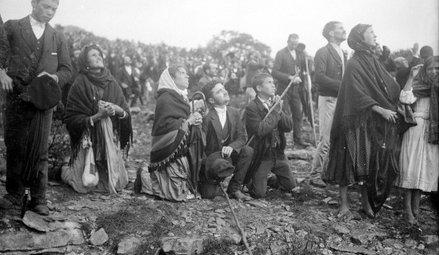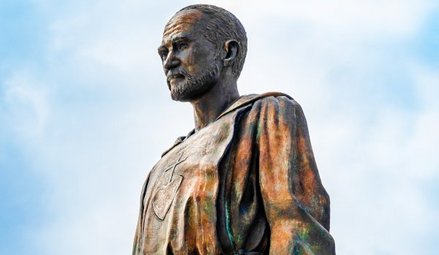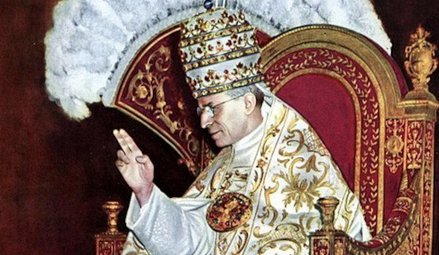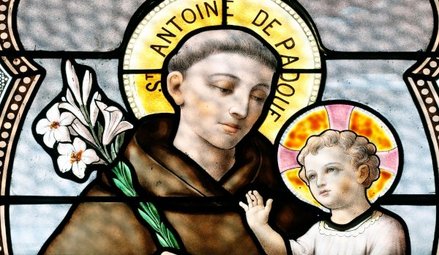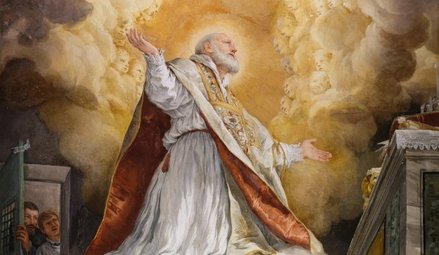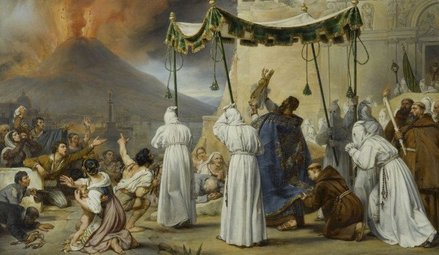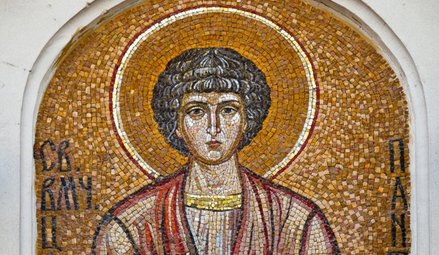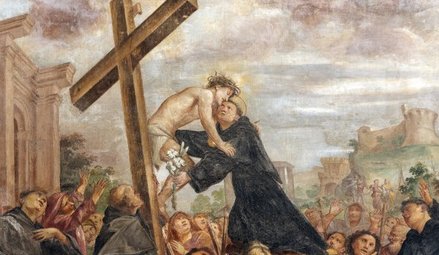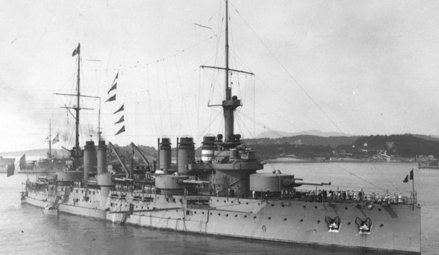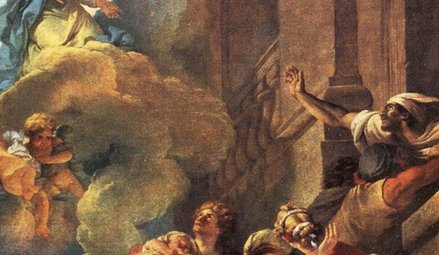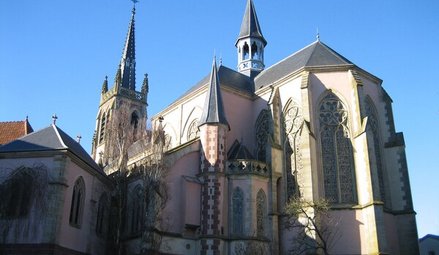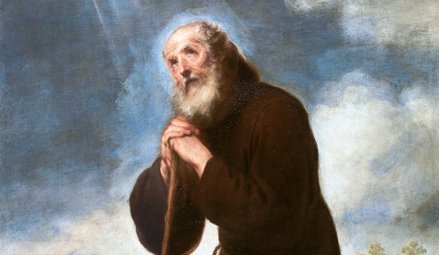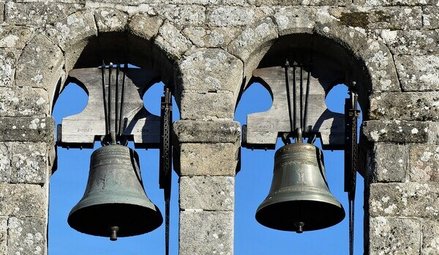- By theme
- Jesus
- The many proofs of Christ’s resurrection
- Saint Thomas Aquinas: God gave all the divine proofs we needed to believe
- The surpassing power of Christ's word
- Lewis’s trilemma: a proof of Jesus’s divinity
- God saves: the power of the holy name of Jesus
- Jesus spoke and acted as God's equal
- Jesus' divinity is actually implied in the Koran
- Jesus came at the perfect time of history
- Rabbinical sources testify to Jesus' miracles
- Mary
- The Church
- The Bible
- An enduring prophecy and a series of miraculous events preventing the reconstruction of the Temple
- The authors of the Gospels were either eyewitnesses or close contacts of those eyewitnesses
- Onomastics support the historical reliability of the Gospels
- The New Testament was not altered
- The New Testament is the best-attested manuscript of Antiquity
- The Gospels were written too early after the facts to be legends
- Archaeological finds confirm the reliability of the New Testament
- The criterion of embarrassment proves that the Gospels tell the truth
- The dissimilarity criterion strengthens the case for the historical reliability of the Gospels
- 84 details in Acts verified by historical and archaeological sources
- The unique prophecies that announced the Messiah
- The time of the coming of the Messiah was accurately prophesied
- The prophet Isaiah's ultra accurate description of the Messiah's sufferings
- Daniel's "Son of Man" is a portrait of Christ
- The Apostles
- Saint Peter, prince of the apostles
- Saint John the Apostle: an Evangelist and Theologian who deserves to be better known (d. 100)
- Saint Matthew, apostle, evangelist and martyr (d. 61)
- James the Just, “brother” of the Lord, apostle and martyr (d. 62 AD)
- Saint Matthias replaces Judas as an apostle (d. 63)
- The martyrs
- The protomartyr Saint Stephen (d. 31)
- Polycarp, bishop of Smyrna, disciple of John and martyr (d. 155)
- Justin Martyr: philosopher and apologist (d.165)
- Saint Blandina and the Martyrs of Lyon: the fortitude of faith (177 AD)
- Saint Agatha stops a volcano from destroying the city of Catania (d. 251)
- Saint Lucy of Syracuse, virgin and martyr for Christ (d. 304)
- Saint Boniface propagates Christianity in Germany (d. 754)
- Thomas More: “The king’s good servant, but God’s first”
- The martyrdom of Paul Miki and his companions (d. 1597)
- The martyrs of Angers and Avrillé (1794)
- The Martyrs of Compiègne (1794)
- The Vietnamese martyrs Father Andrew Dung-Lac and his 116 companions (17th-19th centuries)
- He braved torture to atone for his apostasy (d. 1818)
- Blaise Marmoiton: the epic journey of a missionary to New Caledonia (d. 1847)
- The Uganda martyrs: a recurring pattern in the persecution of Christians (1885)
- José Luis Sanchez del Rio, martyred at age 14 for Christ the King (d. 1928)
- Saint Maximilian Kolbe, Knight of the Immaculate (d. 1941)
- The monks
- The Desert Fathers (3rd century)
- Saint Anthony of the Desert, a father of monasticism (d. 356)
- Saint Benedict, father of Western monasticism (d. 550)
- Saint Bruno the Carthusian (d.1101): the miracle of a hidden life
- Blessed Angelo Agostini Mazzinghi: the Carmelite with flowers pouring from his mouth (d. 1438)
- Monk Abel of Valaam's accurate prophecies about Russia (d. 1841)
- The more than 33,000 miracles of Saint Charbel Maklouf (d. 1898)
- Saint Pio of Pietrelcina (d. 1968): How God worked wonders through "a poor brother who prays"
- The surprising death of Father Emmanuel de Floris (d. 1992)
- The prophecies of Saint Paisios of Mount Athos (d. 1994)
- The saints
- Saints Anne and Joachim, parents of the Virgin Mary (19 BC)
- Saint Nazarius, apostle and martyr (d. 68 or 70)
- Ignatius of Antioch: successor of the apostles and witness to the Gospel (d. 117)
- Saint Gregory the Miracle-Worker (d. 270)
- Saint Martin of Tours: patron saint of France, father of monasticism in Gaul, and the first great leader of Western monasticism (d. 397)
- Saint Augustine of Canterbury evangelises England (d. 604)
- Saint Lupus, the bishop who saved his city from the Huns (d. 623)
- Saint Rainerius of Pisa: from musician to merchant to saint (d. 1160)
- Saint Dominic of Guzman (d.1221): an athlete of the faith
- Saint Francis, the poor man of Assisi (d. 1226)
- Saint Anthony of Padua: "everyone’s saint"
- Saint Rose of Viterbo or How prayer can transform the world (d. 1252)
- Saint Simon Stock receives the scapular of Mount Carmel from the hands of the Virgin Mary
- The unusual boat of Saint Basil of Ryazan
- Saint Agnes of Montepulciano's complete God-confidence (d. 1317)
- The extraordinary conversion of Michelina of Pesaro
- Saint Peter Thomas (d. 1366): a steadfast trust in the Virgin Mary
- Saint Rita of Cascia: hoping against all hope
- Saint Catherine of Genoa and the Fire of God's love (d. 1510)
- Saint Anthony Mary Zaccaria, physician of bodies and souls (d. 1539)
- Saint Ignatius of Loyola (d. 1556): "For the greater glory of God"
- Brother Alphonsus Rodríguez, SJ: the "holy porter" (d. 1617)
- Martin de Porres returns to speed up his beatification (d. 1639)
- Virginia Centurione Bracelli: When God is the only goal, all difficulties are overcome (d.1651)
- Saint Marie of the Incarnation, "the Teresa of New France" (d.1672)
- St. Francis di Girolamo's gift of reading hearts and souls (d. 1716)
- Rosa Venerini: moving in the ocean of the Will of God (d. 1728)
- Saint Jeanne-Antide Thouret: heroic perseverance and courage (d. 1826)
- Seraphim of Sarov (1759-1833): the purpose of the Christian life is to acquire the Holy Spirit
- Camille de Soyécourt, filled with divine fortitude (d. 1849)
- Bernadette Soubirous, the shepherdess who saw the Virgin Mary (1858)
- Saint John Vianney (d. 1859): the global fame of a humble village priest
- Gabriel of Our Lady of Sorrows, the "Gardener of the Blessed Virgin" (d. 1862)
- Father Gerin, the holy priest of Grenoble (1863)
- Blessed Francisco Palau y Quer: a lover of the Church (d. 1872)
- Saints Louis and Zelie Martin, the parents of Saint Therese of Lisieux (d. 1894 and 1877)
- The supernatural maturity of Francisco Marto, “contemplative consoler of God” (d. 1919)
- Saint Faustina, apostle of the Divine Mercy (d. 1938)
- Brother Marcel Van (d.19659): a "star has risen in the East"
- Doctors
- The mystics
- Lutgardis of Tongeren and the devotion to the Sacred Heart
- Saint Angela of Foligno (d. 1309) and "Lady Poverty"
- Saint John of the Cross: mystic, reformer, poet, and universal psychologist (+1591)
- Blessed Anne of Jesus: a Carmelite nun with mystical gifts (d.1621)
- Catherine Daniélou: a mystical bride of Christ in Brittany
- Saint Margaret Mary sees the "Heart that so loved mankind"
- Jesus makes Maria Droste zu Vischering the messenger of his Divine Heart (d. 1899)
- Mother Yvonne-Aimée of Jesus' predictions concerning the Second World War (1922)
- Sister Josefa Menendez, apostle of divine mercy (d. 1923)
- Edith Royer (d. 1924) and the Sacred Heart Basilica of Montmartre
- Rozalia Celak, a mystic with a very special mission (d. 1944)
- Visionaries
- Saint Perpetua delivers her brother from Purgatory (203)
- María de Jesús de Ágreda, abbess and friend of the King of Spain
- Discovery of the Virgin Mary's house in Ephesus (1891)
- Sister Benigna Consolata: the "Little Secretary of Merciful Love" (d. 1916)
- Maria Valtorta's visions match data from the Israel Meteorological Service (1943)
- Berthe Petit's prophecies about the two world wars (d. 1943)
- Maria Valtorta saw only one pyramid at Giza in her visions... and she was right! (1944)
- The location of Saint Peter's village seen in a vision before its archaeological discovery (1945)
- The 700 extraordinary visions of the Gospel received by Maria Valtorta (d. 1961)
- The amazing geological accuracy of Maria Valtorta's writings (d. 1961)
- Maria Valtorta's astronomic observations consistent with her dating system
- Discovery of an ancient princely house in Jerusalem, previously revealed to a mystic (d. 1961)
- Mariette Kerbage, the seer of Aleppo (1982)
- The 20,000 icons of Mariette Kerbage (2002)
- The popes
- The great witnesses of the faith
- Saint Augustine's conversion: "Why not this very hour make an end to my uncleanness?" (386)
- Thomas Cajetan (d. 1534): a life in service of the truth
- Madame Acarie, "the servant of the servants of God" (d. 1618)
- Blaise Pascal (d.1662): Biblical prophecies are evidence
- Madame Élisabeth and the sweet smell of virtue (d. 1794)
- Jacinta, 10, offers her suffering to save souls from hell (d. 1920)
- Father Jean-Édouard Lamy: "another Curé of Ars" (d. 1931)
- Christian civilisation
- The depth of Christian spirituality
- John of the Cross' Path to perfect union with God based on his own experience
- The dogma of the Trinity: an increasingly better understood truth
- The incoherent arguments against Christianity
- The "New Pentecost": modern day, spectacular outpouring of the Holy Spirit
- The Christian faith explains the diversity of religions
- Cardinal Pierre de Bérulle (d.1629) on the mystery of the Incarnation
- Christ's interventions in history
- Marian apparitions and interventions
- The Life-giving Font of Constantinople
- Apparition of Our Lady of La Treille in northern France: prophecy and healings (600)
- Our Lady of Virtues saves the city of Rennes in Bretagne (1357)
- Mary stops the plague epidemic at Mount Berico (1426)
- Our Lady of Miracles heals a paralytic in Saronno (1460)
- Cotignac: the first apparitions of the Modern Era (1519)
- Savona: supernatural origin of the devotion to Our Lady of Mercy (1536)
- The Virgin Mary delivers besieged Christians in Cusco, Peru
- The victory of Lepanto and the feast of Our Lady of the Rosary (1571)
- The apparitions to Brother Fiacre (1637)
- The “aldermen's vow”, or the Marian devotion of the people of Lyon (1643)
- Our Lady of Nazareth in Plancoët, Brittany (1644)
- Our Lady of Laghet (1652)
- Saint Joseph’s apparitions in Cotignac, France (1660)
- Heaven confides in a shepherdess of Le Laus (1664-1718)
- Zeitoun, a two-year miracle (1968-1970)
- The Holy Name of Mary and the major victory of Vienna (1683)
- Heaven and earth meet in Colombia: the Las Lajas shrine (1754)
- The five Marian apparitions that traced an "M" over France, and its new pilgrimage route
- A series of Marian apparitions and prophetic messages in Ukraine since the 19th century (1806)
- "Consecrate your parish to the Immaculate Heart of Mary" (1836)
- At La Salette, Mary wept in front of the shepherds (1846)
- Our Lady of Champion, Wisconsin: the first and only approved apparition of Mary in the US (1859)
- Gietrzwald apparitions: heavenly help to a persecuted minority
- The silent apparition of Knock Mhuire in Ireland (1879)
- Mary "Abandoned Mother" appears in a working-class district of Lyon, France (1882)
- The thirty-three apparitions of the Virgin Mary in Beauraing (1932)
- "Our Lady of the Poor" appears eight times in Banneux (1933)
- Fontanelle-Montichiari apparitions of Our Lady "Rosa Mystica" (1947)
- Mary responds to the Vows of the Polish Nation (1956)
- Zeitoun apparitions
- The Virgin Mary comes to France's rescue by appearing at L'Ile Bouchard (1947)
- Maria Esperanza Bianchini and Mary, Mary, Reconciler of Peoples and Nations (1976)
- Luz Amparo and the El Escorial apparitions
- The extraordinary apparitions of Medjugorje and their worldwide impact
- The Virgin Mary prophesied the 1994 Rwandan genocide (1981)
- Our Lady of Soufanieh's apparition and messages to Myrna Nazzour (1982)
- The Virgin Mary heals a teenager, then appears to him dozens of times (1986)
- Seuca, Romania: apparitions and pleas of the Virgin Mary, "Queen of Light" (1995)
- Angels and their manifestations
- Mont Saint-Michel: Heaven watching over France
- The revelation of the hymn Axion Estin by the Archangel Gabriel (982)
- Angels give a supernatural belt to the chaste Thomas Aquinas (1243)
- The constant presence of demons and angels in the life of St Frances of Rome (d. 1440)
- Mother Yvonne-Aimée escapes from prison with the help of an angel (1943)
- Saved by Angels: The Miracle on Highway 6 (2008)
- Exorcisms in the name of Christ
- A wave of charity unique in the world
- Saint Peter Nolasco: a life dedicated to ransoming enslaved Christians (d. 1245)
- Rita of Cascia forgives her husband's murderer (1404)
- Saint Angela Merici: Christ came to serve, not to be served (d. 1540)
- Saint John of God: a life dedicated to the care of the poor, sick and those with mental disorders (d. 1550)
- Saint Camillus de Lellis, reformer of hospital care (c. 1560)
- Blessed Alix Le Clerc, encouraged by the Virgin Mary to found schools (d. 1622)
- Saint Vincent de Paul (d. 1660), apostle of charity
- Marguerite Bourgeoys, Montreal's first teacher (d. 1700)
- Frédéric Ozanam, inventor of the Church's social doctrine (d. 1853)
- Damian of Molokai: a leper for Christ (d. 1889)
- Pier Giorgio Frassati (d.1925): heroic charity
- Saint Dulce of the Poor, the Good Angel of Bahia (d. 1992)
- Mother Teresa of Calcutta (d. 1997): an unshakeable faith
- Heidi Baker: Bringing God's love to the poor and forgotten of the world
- Amazing miracles
- The miracle of liquefaction of the blood of St. Januarius (d. 431)
- The miracles of Saint Anthony of Padua (d. 1231)
- Saint Pius V and the miracle of the Crucifix (1565)
- Saint Philip Neri calls a teenager back to life (1583)
- The resurrection of Jérôme Genin (1623)
- Saint Francis de Sales brings back to life a victim of drowning (1623)
- Saint John Bosco and the promise kept beyond the grave (1839)
- The day the sun danced at Fatima (1917)
- Pius XII and the miracle of the sun at the Vatican (1950)
- When Blessed Charles de Foucauld saved a young carpenter named Charle (2016)
- Reinhard Bonnke: 89 million conversions (d. 2019)
- Miraculous cures
- The royal touch: the divine thaumaturgic gift granted to French and English monarchs (11th-19th centuries)
- With 7,500 cases of unexplained cures, Lourdes is unique in the world (1858-today)
- Our Lady at Pellevoisin: "I am all merciful" (1876)
- Mariam, the "little thing of Jesus": a saint from East to West (d.1878)
- The miraculous healing of Marie Bailly and the conversion of Dr. Alexis Carrel (1902)
- Gemma Galgani: healed to atone for sinners' faults (d. 1903)
- The miraculous cure of Blessed Maria Giuseppina Catanea
- The extraordinary healing of Alice Benlian in the Church of the Holy Cross in Damascus (1983)
- The approved miracle for the canonization of Juan Diego Cuauhtlatoatzin (1990)
- Healed by St Charbel Makhlouf, her scars bleed each month for the benefit of unbelievers (1993)
- The miracle that led to Brother André's canonisation (1999)
- Bruce Van Natta's intestinal regrowth: an irrefutable miracle (2007)
- He had “zero” chance of living: a baby's miraculous recovery (2015)
- Manouchak, operated on by Saint Charbel (2016)
- How Maya was cured from cancer at Saint Charbel's tomb (2018)
- Preserved bodies of the saints
- Dying in the odour of sanctity
- The body of Saint Cecilia found incorrupt (d. 230)
- Saint Claudius of Besançon: a quiet leader, a calm presence, and a strong belief in the value of prayer (d. 699)
- Stanislaus Kostka's burning love for God (d. 1568)
- Saint Germaine of Pibrac: God's little Cinderella (d. 1601)
- Blessed Antonio Franco, bishop and defender of the poor (d. 1626)
- Giuseppina Faro, servant of God and of the poor (d. 1871)
- The incorrupt body of Marie-Louise Nerbollier, the visionary from Diémoz (d. 1910)
- The great exhumation of Saint Charbel (1950)
- Bilocations
- Inedias
- Levitations
- Lacrimations and miraculous images
- Saint Juan Diego's tilma (1531)
- The Rue du Bac apparitions of the Virgin Mary to St. Catherine Labouré (Paris, 1830)
- Mary weeps in Syracuse (1953)
- Teresa Musco (d.1976): salvation through the Cross
- Soufanieh: A flow of oil from an image of the Virgin Mary, and oozing of oil from the face and hands of Myrna Nazzour (1982)
- The Saidnaya icon exudes a wonderful fragrance (1988)
- Our Lady weeps in a bishop's hands (1995)
- Stigmates
- The venerable Lukarda of Oberweimar shares her spiritual riches with her convent (d. 1309)
- Florida Cevoli: a heart engraved with the cross (d. 1767)
- Blessed Maria Grazia Tarallo, mystic and stigmatist (d. 1912)
- Saint Padre Pio: crucified by Love (1918)
- Elena Aiello: "a Eucharistic soul"
- A Holy Triduum with a Syrian mystic, witnessing the sufferings of Christ (1987)
- A Holy Thursday in Soufanieh (2004)
- Eucharistic miracles
- Lanciano: the first and possibly the greatest Eucharistic miracle (750)
- A host came to her: 11-year-old Imelda received Communion and died in ecstasy (1333)
- Faverney's hosts miraculously saved from fire
- A tsunami recedes before the Blessed Sacrament (1906)
- Buenos Aires miraculous host sent to forensic lab, found to be heart muscle (1996)
- Relics
- The Veil of Veronica, known as the Manoppello Image
- For centuries, the Shroud of Turin was the only negative image in the world
- The Holy Tunic of Argenteuil's fascinating history
- Saint Louis (d. 1270) and the relics of the Passion
- The miraculous rescue of the Shroud of Turin (1997)
- A comparative study of the blood present in Christ's relics
- Jews discover the Messiah
- Francis Xavier Samson Libermann, Jewish convert to Catholicism (1824)
- Our Lady of the Miraculous Medal and the conversion of Alphonse Ratisbonne (1842)
- Max Jacob: a liberal gay Jewish artist converts to Catholicism (1909)
- Edith Stein - Saint Benedicta of the Cross: "A daughter of Israel who, during the Nazi persecutions, remained united with faith and love to the Crucified Lord, Jesus Christ, as a Catholic, and to her people as a Jew"
- Patrick Elcabache: a Jew discovers the Messiah after his mother is miraculously cured in the name of Jesus
- Olivier's conversion story: from Pesach to the Christian Easter (2000)
- Cardinal Aron Jean-Marie Lustiger (d. 2007): Chosen by God
- Muslim conversions
- He met Jesus while looking for Muhammad (1990)
- Selma's journey to baptism (1996)
- Soumia, converted to Jesus as she hears Christmas carols (2003)
- How Aïsha, a Muslim convert, found Jesus (2004)
- Amir chooses Christ, at the risk of becoming homeless (2004)
- Souad Brahimi: brought to Jesus by Mary (2012)
- Pursued by God: Khadija's story (2023)
- Buddhist conversions
- Atheist conversions
- The conversion of an executioner during the Terror (1830)
- God woos a poet's heart: the story of Paul Claudel's conversion (1886)
- From agnostic to Catholic Trappist monk (1909)
- Dazzled by God: Madeleine Delbrêl's story (1924)
- C.S. Lewis, the reluctant convert (1931)
- The day André Frossard met Christ in Paris (1935)
- MC Solaar's rapper converts after experiencing Jesus' pains on the cross
- Father Sébastien Brière, converted at Medjugorje (2003)
- Franca Sozzani, the "Pope of fashion" who wanted to meet the Pope (2016)
- Nelly Gillant: from Reiki Master to Disciple of Christ (2018)
- Testimonies of encounters with Christ
- Near-death experiences (NDEs) confirm Catholic doctrine on the Four Last Things
- The NDE of Saint Christina the Astonishing, a source of conversion to Christ (1170)
- Jesus audibly calls Alphonsus Liguori to follow him (1723)
- Blessed Dina Bélanger (d. 1929): loving God and letting Jesus and Mary do their job
- Gabrielle Bossis: He and I
- André Levet's conversion in prison
- Journey between heaven and hell: a "near-death experience" (1971)
- Jesus' message to Myrna Nazzour (1984)
- Alicja Lenczewska: conversations with Jesus (1985)
- Vassula Ryden and the "True Life in God" (1985)
- Nahed Mahmoud Metwalli: from persecutor to persecuted (1987)
- The Bible verse that converted a young Algerian named Elie (2000)
- Invited to the celestial court: the story of Chantal (2017)
- Providential stories
- The superhuman intuition of Saint Pachomius the Great
- Ambrose of Milan finds the bodies of the martyrs Gervasius and Protasius (386)
- Germanus of Auxerre's prophecy about Saint Genevieve's future mission, and protection of the young woman (446)
- Seven golden stars reveal the future location of the Grande Chartreuse Monastery (1132)
- The supernatural reconciliation of the Duke of Aquitaine (1134)
- Saint Zita and the miracle of the cloak (13th c.)
- Joan of Arc: "the most beautiful story in the world"
- John of Capistrano saves the Church and Europe (1456)
- A celestial music comforts Elisabetta Picenardi on her deathbed (d. 1468)
- Gury of Kazan: freed from his prison by a "great light" (1520)
- The strange adventure of Yves Nicolazic (1623)
- Julien Maunoir miraculously learns Breton (1626)
- Pierre de Keriolet: with Mary, one cannot be lost (1636)
- How Korea evangelized itself (18th century)
- A hundred years before it happened, Saint Andrew Bobola predicted that Poland would be back on the map (1819)
- The prophetic poem about John Paul II (1840)
- Don Bosco's angel dog: Grigio (1854)
- The purifying flames of Sophie-Thérèse de Soubiran La Louvière (1861)
- Thérèse of Lisieux saved countless soldiers during the Great War
- Lost for over a century, a Russian icon reappears (1930)
- In 1947, a rosary crusade liberated Austria from the Soviets (1946-1955)
- The discovery of the tomb of Saint Peter in Rome (1949)
- He should have died of hypothermia in Soviet jails (1972)
- God protects a secret agent (1975)
- Flowing lava stops at church doors (1977)
- A protective hand saved John Paul II and led to happy consequences (1981)
- Mary Undoer of Knots: Pope Francis' gift to the world (1986)
- Edmond Fricoteaux's providential discovery of the statue of Our Lady of France (1988)
- The Virgin Mary frees a Vietnamese bishop from prison (1988)
- The miracles of Saint Juliana of Nicomedia (1994)
- Global launch of "Pilgrim Virgins" was made possible by God's Providence (1996)
- The providential finding of the Mary of Nazareth International Center's future site (2000)
- Syrian Monastery shielded from danger multiple times (2011-2020)
- Jesus
- Who are we?
- Make a donation
EVERY REASON TO BELIEVE
Des miracles étonnants
n°318
Naples (Italy)
From 431 to the present day
The miracle of liquefaction of the blood of St. Januarius
Since 431, the blood of the Neapolitan martyr Saint Januarius (272 - 305), piously collected by Eusebia, his former nurse, and preserved in two glass vials in the Cathedral of Our Lady of the Assumption in Naples, has inexplicably liquefied three times a year during liturgical ceremonies attended by thousands of people, all eyewitnesses to the occurences.
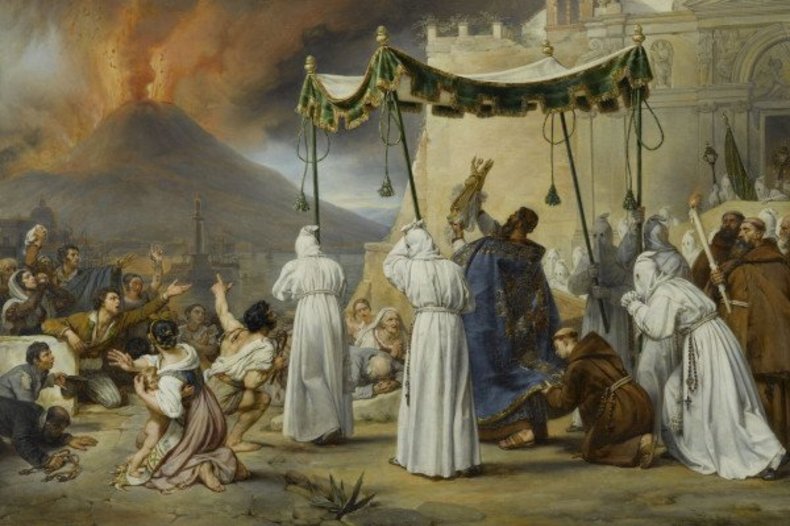
Antoine Jean-Baptiste Thomas, The procession of the relics of Saint Janvier in 1822, during the eruption of Mount Vesuvius, 1822, Château de Versailles / © CC0/wikimedia
Reasons to believe:
- Since 1500 (this date is not that of the building of the Neapolitan cathedral, which began in 1290, but of its reconstruction after the collapse of 1456), around 1,000 people have attended each of the three annual ceremonies, making a total of 3,000 witnesses a year. If we multiply this figure by the number of years that have passed since then, we arrive at a total of at least 1.5 million direct witnesses - a figure that necessarily increases if we include the years 1290-1500.
- Sometimes liquefaction does not occur, even though the Cardinal Archbishop of Naples has been making the same gestures and uttering the same words for centuries: it can therefore in no way be a purely physical-chemical process.
- Liquefaction is one miracle, and the absence of liquefaction is another: Every time the blood did not become liquid, Naples and the surrounding region invariably experienced serious difficulties in the weeks or months that followed; for example, in 1528 (plague epidemic), 1698 (eruption of Vesuvius), 1767 and 1779 (new major lava flows affecting the surrounding villages), 1980 (earthquake killing more than 2,000 inhabitants), etc.
- Conversely, liquefaction systematically indicates that the city will not suffer any disasters and that it will be protected in some inexplicable way: 1497 (surprising end to a plague epidemic), 1631 (sudden halt to the eruption of Vesuvius), 1944 (lava flows invading several villages around Naples literally freeze), etc.
- One of the countless prophecies linked to the miracle of liquefaction is that of May 1799, when Napoleon's troops occupied Naples. It was a bad omen that the blood remained clotted. A few days later, the French army was forced to leave the city.
- Accumulated over half a millennium, with 22,000 precious objects (gold, precious stones) donated by faithful Italians and other nationalities, the "Treasure" of Saint Januarius bears witness to the martyr's extraordinary popularity, which was unceasing and widespread, whatever the reigning dynasty in Naples.
- Saint Januarius's blood does not coagulate according to an "immutable" process, regulated by a strict scientific protocol: it may only become liquid after several minutes, or even at the end of the ceremony; only part of the contents of the vials may become liquid while the other half remains coagulated, thus ruling out any possible natural explanation (human blood coagulates in a few seconds); sometimes the liquefaction begins before the glasss ampoules are removed from the cabinet, which also rules out the hypothesis of a natural action by manual manipulation and raising the temperature of the vials.
- In 1965, while some people were questioning the authenticity of the relics of Saint Janvier, Italian professor Giuseppe Lambertini established that the skeleton he had analysed was that of a man of around thirty-five years of age: in fact, the saint died at the age of thirty-three.
- Witnesses to the liquefaction miracles came from all walks of life and included many people who had no interest in lying or promoting false miracles: municipal, regional and national officials, ambassadors, captains of industry, Catholic prelates and various religious leaders.
- Even popes come to these ceremonies: Blessed Pius IX in 1849, and Francis in 2015, took part in one of the three annual ceremonies. The Roman pontiffs would never have travelled, especially in public, if they had not believed in these recurring miracles. Rome was notoriously cautious in such matters.
- It has been claimed that the contents of the vials could have been "prepared" and manipulated before the ceremonies. This is totally false. In fact, theliturgical niche containing the two vials and the saint's relics is closed by two solid silver doors, themselves locked by two keys, one of which is personally guarded by the archbishop of Naples and the other by a representative of the "Deputies", a company of lay people whose members are chosen by lot to prevent any abuse. Apart from these two people, no one in the world can open the niche.
- There are plenty of films and reports from all over the world showing the miracle as it happens.
- It is naturally possible to liquefy coagulated blood by breaking down the fibrin (fibrous protein) that traps the blood cells, by injecting an alcoholic solution for example. But no one has ever caught anyone adding a product to the flasks: they have been hermetically sealed for centuries; moreover, blood dissolved by a natural process cannot become solid again, like Saint Januarius's! What's more, natural liquefaction can only happen once, unlike the countless occurrence of Januarius's blood in the Naples Cathedral.
- In the 1980s, the Italian Committee for the Investigation of Claims on Pseudosciences (CICAP, an Italian non-profit skeptical educational organization, founded in 1989, whose main goal is to promote a scientific and critical investigation of pseudosciences, the paranormal, so-called mysteries and the unusual, with the aim of encouraging a more scientific attitude and critical thinking) put forward the idea that liquefaction was induced by "thixotropy" (liquefaction of certain substances by agitation); in 1981, French professor Henri Broch took up such an explanation after enclosing jojoba or coconut oil in an ampoule and drawing similar conclusions. None of these hypotheses offers the slightest explanation of the realities of the miracles of Saint Januarius's blood: partial and sometimes non-existent liquefaction, maintenance of the liquefied state for several days without any manipulation of the vials, and so on.
- In 1989, Italian Professor Pier Luigi Baima Bollone, Director of the Institute of Forensic Medicine at the University of Turin, definitively established by means of spectrographic analysis that the two vials did indeed contain haemoglobin, which had been discovered in 1898 and again in 1902 using less sophisticated means of investigation.
- In 1991, three Italian researchers announced that they had devised a solution identical to that in the holy vials, using products already known in the Middle Ages (calcium carbonate, sodium chloride, iron chloride, etc.) - liquids that could solidify when shaken. What's more, without human intervention (i.e. shaking), nothing happens, which is completely different from the Naples miracle, since liquefaction can occur even before the vials are removed from their niche.
In 2005, the Italian astrophysicist Margarita Hack took up such hypotheses, declaring that the vials contained a "chemical composition based on iron, dating from the Middle Ages, which is solid if left untouched, but becomes liquid when shaken" (La Stampa): once again, this statement completely fails to take into account the very specific ways in which the miracles of liquefaction performed by the two vials were unique and therefore impossible to reproduce in a laboratory.
Summary:
Saint Januarius (21 April 272 - 19 September 305) was a Neapolitan Catholic of noble origin, bishop of Benevento (now Campania, Italy), who was martyred during the persecutions under the reigh of Emperor Diocletian.
Januarius was arrested in September 305 along with two other Christians, on the orders of Dragonsus, proconsul of Campania, while visiting a deacon named Sosius. Refusing to renounce his faith, he had his head cut off near the Solfatare in Pozzuoli, in the forum known as Vulcano. Some of his blood was collected by a woman called Eusebia, his former nurse.
The veneration of this martyr appeared very early on. In 431, his body was transported from Agnano, where he had died, to the Capodimonte catacombs in Naples, where a fresco depicts the saint's head surrounded by two candles. It is highly likely that he was already being discreetly worshipped by Christians.
The first miracle of blood liquefaction took place in 431, during the transfer of the saint's relics. The procession carrying the relics stopped off in what is now Piazza Bernini, where the blood, carried by Eusebia, began to "bubble" in the presence of the Bishop of Naples.
In 512, Stephen I, Bishop of Naples, had a small church built in his honour, into which the skull and the two ampoules of blood were transported. In the 7th century, another place of worship was built on the site of Saint Januarius's martyrdom, which was itself replaced in 1580 by a much larger church, the "Shrine of Saint Januarius", in La Solfatare.
Hidden away to avoid the Lombard raids in the region, the blood of Saint Januarius was the object of intense and immense popular devotion throughout the Middle Ages. Two ceremonies were held each year (on 13 April, the date on which the saint's relics were transferred to Naples, and on 19 September, the anniversary of his execution), during which the blood inexplicably liquefied in the hands of the Bishop of Naples (and then the Archbishop from the early 11th century onwards), leading to exceptional collective jubilation throughout the city. Saint Januarius, who became the patron saint of the Neapolitan city, enjoyed exceptional popularity among the Italians, with the faithful believing that he was responsible for spectacular miracles that saved and protected the population, such as the ending of epidemics and the stopping of the eruption of Vesuvius.
These two annual events are mentioned in the Naples liturgical calendar as far back as the episcopate of Athanasius I (849-872).
The three annual ceremonies during which the miracles take place, as we know them today, were established at the same time as the construction of Naples Cathedral, dedicated to Our Lady of the Assumption, which began in 1290 but was not completed until the end of the 15th century.
Every 16 December (in reference to the miracle of the end of the eruption of Vesuvius on 16 December 1631), every Saturday before the first Sunday in May (the transfer of the saint's body from Pozzuoli to Naples), and every 19 September (the anniversary of his martyrdom), the archbishop of Naples takes hold of the handle of the reliquary containing the miraculous vials to display them for the veneration of the faithful.
The reigning dynasties of Naples maintained the feasts of Saint Januarius and great devotion to the miraculous blood without any discontinuity or decrease in popular devotion. Over the years, the "treasure" offered to the saint (i.e precious gifts given to the cathedral) continued to grow, proving the strength of the bond between the Neapolitans and their patron saint. In 1527, a confraternity of twelve families (lay people, including some municipal officials) was set up to guard the treasure; in 1679, a priceless gold necklace set with precious stones, designed by Michele Dato, became part of the treasure. In 1931, King Humbert II of Italy and his wife Marie-José of Belgium donated a solid gold and coral ciborium to the treasury. In all, 22,000 gifts have been given to the treasury of Saint Januarius.
Three times a year, in front of a packed church, the archbishop of Naples first celebrates mass, after which he extracts the two vials containing the saint's blood from the special cabinet, which he then raises in front of the faithful. If the blood liquefies, it is a good sign; on the other hand, if it remains solid, Naples will experience difficulties in the current year. These prophecies have been fulfilled ever since the first ostensions of the relics.
Voltaire and the philosophers of the eighteenth century have made ironic comments about the miracles of Saint Januarius and, since the end of the nineteenth century, several analyses have been carried out, apart from the study of the liquid contained in the two ampoules, which would involve extracting it without knowing what would happen to it. To put it briefly, none of these analyses took into account the incomparable circumstances in which miracles occur: firstly, from a prophetic and spiritual point of view, non-liquification is a miracle that certainly heralds a catastrophe (scientists obviously don't see this phenomenon of the liquid not disintegrating as any kind of prodigy); secondly: liquefaction can occur at times that are scientifically improbable, either before the vials have even been removed from their reliquary, or at a totally indeterminate moment (sometimes hours after the containers have been "shaken" in the hands of the Neapolitan archbishop, which definitively contradicts the supporters of the theory that manual shaking of the vials is the cause of liquefaction), or at the end of the ceremony. What's more, the blood can remain in a liquid state for days on end, something that has never happened under natural conditions.
Patrick Sbalchiero
Beyond reasons to believe:
If the miracle of liquefaction had taken place only once, or only on a few dates scattered throughout history, we could legitimately question the authenticity of the phenomenon. But this miracle has been attested to for over fifteen centuries, not by isolated witnesses, churchmen or small groups of fervent believers, but by tens of thousands of people from all walks of life, of all ages and from all socio-cultural backgrounds.
Going further:
- "Janvier (saint)", Dictionnaire d'Histoire et de Géographie Ecclésiastiques, vol. 26, Paris, 1997, col. 983-989.









